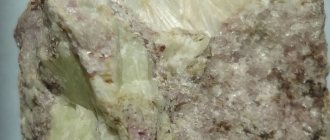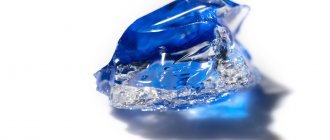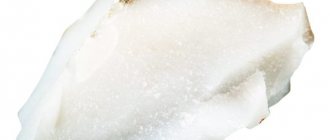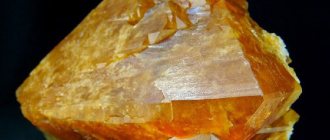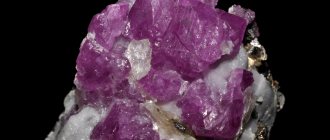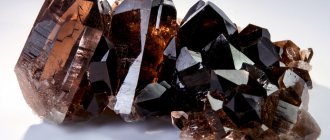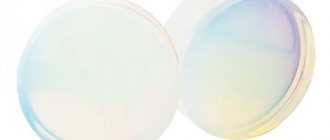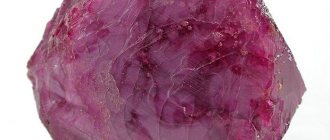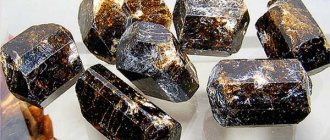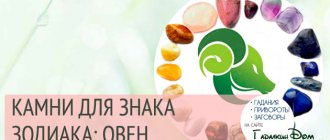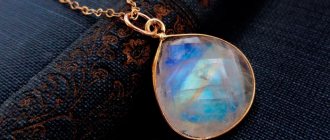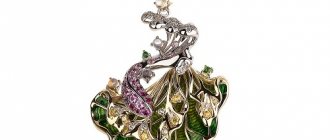Corundum is a stone of natural origin. Its variety may be the more familiar sapphire or ruby. There are also artificial analogs of crystals that have an affordable price, but in terms of physical and technical parameters they closely resemble the original. Natural gemstones are mined in many countries around the world. In this case, the final properties of the gem can be obtained after temperature or chemical exposure. So, corundum - what kind of stone is it? This is discussed in detail below.
Corundum is a stone that has a beautiful appearance.
What kind of stone is corundum - description
Corundums belong to a group of minerals; not only their physical properties are similar, but also their chemical properties and structure. Some time ago it was believed that the various types obtained from corundum were independent materials. But very quickly this opinion was dispelled by chemistry and geology; today it is clearly clear that sapphires, rubies and alexandrites, belonging to the same group, are only varieties of corundum.
Where did the name of the stone come from? The name is believed to be derived from the words "kauruntaka" and "kuruvinda", which means ruby in Sanskrit.
But there is also pure corundum without impurities. This stone is very rare, so its cost is very high all over the world, but wearing it as jewelry is not a cheap pleasure. A distinctive feature of pure corundum is its complete transparency, it has no color and has a glassy luster. It looks like a diamond.
The colored varieties of the mineral are most often mined because it contains colloids that give it color. Shades of blue, cyan, green, scarlet and violet are found in a wide variety of colors. Since time immemorial, red corundum has been highly valued as it is associated with power.
Areas of use of corundum
Depending on the physical and aesthetic conditions of corundum, the scope of application of the raw material is different.
Jewelry
In jewelry, the best examples of natural or synthetic materials are in demand. Gems are inserted into earrings, pendants, rings, brooches, and bracelets.
Ring with corundum
Men's segment - rings, cufflinks, tie clips.
The publicly available assortment of jewelry stores is synthetic corundum in 925° silver or 585° gold. Elite - real in high-carat gold or platinum.
The cost of budget accessories is thousands of rubles. Prices in the premium segment are tens of thousands.
Artificial corundums are valued at 100–700 rubles.
Before and after treatment
Other areas
Durable artificial raw materials, rejected by jewelers, are used by industry:
- abrasive material in grinding machines; sometimes it’s just a whetstone or regular sandpaper;
- products from the radio electronics and precision engineering industries (lasers, drilling rig parts, medical instruments);
- glass in rockets, airplanes, mobile gadgets - synthetic sapphire;
- parts of luxury wristwatch mechanisms;
- thermal insulation (a millimeter corundum layer is similar to 50 mm of mineral wool);
- grinding paste.
In the era of vinyl records, “eternal” styli for turntables were made from corundum.
Physical properties of corundum
The largest percentage of corundum consists of aluminum oxide. Iron, magnesium, nickel, titanium and vanadium are also present in varying proportions. Industrial corundum contains more iron, chromium in red carbuncles and titanium in dark blue sapphires. Bright, characteristic colors can be obtained using technical means: irradiation or heating. These methods are often used in the production of synthetic stones.
Pure corundum is characterized by high hardness and transparency with a glassy luster. Its hardness is 9 on the Mohs scale and its density varies from 3.95 to 4.1 s/cm³. The melting point of the mineral is more than 2030˚C. The crystal is insoluble in chemical acids.
The most famous varieties of corundum are sapphires and rubies. The latter often compete in price with pure diamonds. Ruby colors range from dark pink to cherry red. The most expensive stones are burgundy.
Main varieties of corundum
1. Sapphire. Their value is slightly lower than rubies. But in appearance they are as beautiful as rubies, and their physical properties are in no way inferior to their competitors. But buyers more often choose red rubies than blue sapphires. Sapphires come with a blue or blue tint. The darker the color, the more expensive the price of the stone. Cornflower blue is considered one of the most expensive shades. It is mined on the island of Ceylon. Sapphire is perfectly transparent and rich in color. If the color is darker or lighter than cornflower blue, then the price is already reduced. 2. Ruby. This is red corundum. Since the shade of the stone depends on the chemical composition, that is, on the impurities that it contains, pure ruby is extremely rare in nature; its shades can be very different. It contains chromium oxide, which gives it a rich scarlet hue. The mineral is transparent, the shade can be very saturated and less saturated. The most expensive shade is dark cherry. The stone is so valuable that it is more expensive than diamonds, and some pieces are more expensive than diamonds. If red corundum has a brownish tint, then its value decreases. Therefore, a color such as “ruby” can imply shades from red to blue. 3. Gray corundum. The mineral is translucent and has a blue tint. 4. Leucosapphire. Corundum is transparent and resembles diamond in appearance. 5. Yellow corundum. Another name for the mineral is padparadscha. These stones come in orange and yellow shades. This happens thanks to the iron in their composition. If the composition contains nickel, due to which the stone received a yellow color, then it is called yellow sapphire. 6. Alexandrite. This stone is natural, its cost is high. A synthetic mineral is often produced based on synthetic corundum, to which vanadium is added. The result is a nice pebble, but it does not have any special properties - healing or magical. The artificial stone is best called corundum, which has the effect of alexandrite. 7. Oriental emerald. Green corundum. Outwardly, it looks like an emerald, which is why it is called that. 8. Pink stone. It contains manganese, which is why the stone has a pink color.
Corundums come in a variety of colors. Pure corundums are rarely found. Green crystals are even rarer, but it is more layered, as it has alternating yellow and blue layers, which when exposed to light gives a distinct green tint.
If the corundum is natural, relatively large and transparent, of course it will be highly valued, since such a specimen is rare. Synthetic corundum is produced in hundreds of kilograms, so it has no special value.
The most famous corundum is ruby
There are several types of rubies:
- Stellate. Rare minerals. The origin of the name is closely related to their appearance. Its main feature is the star, which is clearly visible on the polished crystal.
- Ceylon. Rubies of unusual color - lilac and purple. The main place of production is Sri Lanka.
- Siamese ruby. Thai stones are also known for their unusual colors and high clarity.
- Burmese. Natural stone with “pigeon blood color”. They have the brightest fluorescent red color that is visible regardless of lighting.
- Tanzanian. Rubies of the darkest shade. The stones mined in Songea are considered the purest in the world.
Sapphires and alexandrites
The second precious variety of corundum is sapphire. The base color can vary from pale blue to dark blue. The wide range of colors also provides species diversity:
- Chlorosapphires. A green mineral that is often confused with emerald.
- Padparadscha. Translated from Sanskrit as “lotus flower”. Stones with pink, orange and yellow hues.
- Leucosapphires. The second name is “oriental diamonds”. The main difference is the lack of color, transparency.
- Alexandrite . Unique minerals that, like alexandrite, can change their color when exposed to light.
Also worth mentioning is emery, an industrial form of corundum that is mixed with magnetite and used as an abrasive.
Where are the stones mined?
Most corundum is mined in the “Asian quadrangle” - India, Myanmar, Sri Lanka, Thailand (formerly Siam).
The world's proven reserve of rubies is twenty times less than that of sapphire.
The world's best rubies come from Mogok (Myanmar, former Burma) and Sri Lanka; premium sapphires come from Indian Kashmir.
There are other mining sites. Australia and African Tanzania are sources of rare green and black sapphires.
A natural stone
In America, Canada and the USA have stones. Europe is represented by Norway, Turkey, Greece.
In Russia, corundum is mined in the polar Urals, Krasnoyarsk and Primorsky territories.
The newest deposit of stones is from Kazakhstan.
Corundum group
A group of minerals called corundum is not found in nature as often as lovers and collectors of precious stones would like. And this is not surprising. After all, it is one of the most majestic gemstones that can be found on Earth. A specimen with a red color is called a ruby, while a specimen with blue and bluish tints is called a sapphire.
There are many legends about these stones, and historical evidence suggests that corundums have had value since ancient times.
Corundum crystals are pyramidal, barrel-shaped or columnar. Each individual specimen can reach 10 centimeters in diameter. In nature, corundum is found mainly in the form of inclusions in other rocks. Therefore, finding a complete, undeformed specimen is quite a difficult task.
Corundum deposits and mining
There are several types of deposits where corundum stone is most often found.
- Magma deposits - similar corundum formations in the earth's crust have not been fully studied. However, deposits of valuable sapphires are typical for this type of rock. Such deposits include Thailand and the USA.
- Pegmatite is a type of hard stone that often forms in alkaline rocks. Sometimes small inclusions of corundum can be found in its inner part. Such deposits are typical for Canada, South Africa and some regions of Russia (Ilmen Mountains).
- The most common are skarns - rubies and sapphires. The most famous deposit is in Burma.
- Hydrothermal - as a result of the thermochemical reaction occurring in this case, corundum mica is formed, which is not used for jewelry purposes. However, ruby mica is highly prized by collectors. Similar formations have been discovered in Kazakhstan, Tanzania and Russia.
- Placer - Placer minerals are sometimes found near the above deposits.
- Metamorphogenic - marble and limestone have a swelling formation. There are also clusters of rubies here. In Russia, similar deposits are located in the Krasnoyarsk Territory.
In the Middle Ages, Southeast Asia (India, Thailand and Burma) was considered the only source of valuable corundum. Today these stones are mined in Canada, the USA, on the island of Madagascar and other countries. There are nuggets in Russia, but their reserves are much smaller than in other countries.
Related rock corundum
In nature there are often amazing examples of combinations of nuggets. Needle-shaped crystals are especially common inside large minerals. Such specimens are especially valued by jewelers and gem connoisseurs.
Raw corundum is usually found not separately as a scattering of precious stones, but within some solid parent rock. It can be feldspar, quartz, andalusite, rutile, spinel, mica or even regular granite.
In order not to lose valuable carats, experts carefully remove the gemstone, trying not to destroy its rocky surface.
History and origin
Corundum is a precious mineral. In terms of hardness, the stone follows the diamond. The colors of the mineral depend on impurities (vanadium, chromium, iron). Depending on their presence, the gem acquires orange, yellowish, predominantly red and blue shades.
It is known to mankind under various names. Some of them are derived from an indication of the area where it was mined:
- oriental (peridot, topaz, emerald, hyacinth, amethyst, diamond, aquamarine);
- the old Russian name for varieties of gems is “yakhont”;
- Bengal amethyst;
- In metalworking, the mineral is called emery.
Corundum has been pleasing humanity with its unearthly beauty since ancient times. Luxurious jewelry adorned the women of Ancient Egypt and Jerusalem. Their sophistication and sophistication are well known in India, where the gemstone has gained popularity.
Rubies and sapphires are aluminum oxide crystals mined in nature:
- in the form of crystalline groups;
- inclusions;
- grains
They come in various shapes (in the form of cubes, prisms, cones). Opaque minerals have larger shapes (about a meter). Transparent samples can reach 10 cm.
In Europe, the stone originated from South Asia and India, where it was mined. It was widely used in many areas of human activity:
- In mechanical engineering, durable glasses for sapphire devices are used.
- In metalworking, Corundum is used as emery.
- For the scientific world, this is aluminum oxide.
- Jewelers use the mineral to create luxurious jewelry.
In love with the gem for its extraordinary variety of colors and purity of lines, they have been making magnificent jewelry from the mineral since ancient times:
- Red Corundum, which bears the name “Ruby,” is valued higher than diamonds in the jewelry market.
- In terms of the perfection of its pale blue radiance and complex pyramidal cut, the ruby surpasses the sapphire with the enchanting name “Blue Princess” weighing 114 carats (22.8 g). The jewel belongs to a Dutch jewelry house.
- The purity of the blue color of sapphire cabochons with a clearly visible asterism (six-pointed star) has long been the subject of gifts and exchanges. It is considered good form in high diplomacy to present the ruler of a neighboring state with blue or red Corundum.
- Over 31 carats in octagonal sapphire rose, kept in the UK collection. In the 17th century, jewelry was the property of Sir Hans Sloane, an English educator.
Large corundums are considered rare. It is known that in the USA portraits of presidents were made from large sapphires of medium quality. Natural history museums around the world store druses of Corundum crystals up to several tens of kg.
Valuable properties of corundum stones
There are many different descriptions and images of this group of precious stones; it is known that people fell in love with these gems not only for their beautiful appearance. Since time immemorial, the most expensive and desirable acquisition has been pure and transparent corundum with an asterism effect, that is, one that, when polished, takes on the shape of a star.
Since ancient times, blue and red corundums have been greatly loved and respected by people; yellow corundums, on the contrary, were not in demand. Sapphires and rubies were decorations of the great pharaohs and priests of Egypt. These stones were considered symbols of strength and power. Also, these gems were very loved in India.
People believed that in addition to beauty, nuggets of this gem had healing and magical powers. For example, it was believed that rubies ward off bad luck and the evil eye, and sapphires - against diseases of the organ of vision.
Symbolism of the stone
The history of corundum goes back thousands of years. It has always been an attribute of power: the priests of Ancient Egypt and the high priests of Judea decorated their robes with sapphires.
Since the Middle Ages, corundum has been known in Russia. A little later they were brought to Europe from India by merchants.
The established meaning of the scarlet stone is chosenness, power, greatness. The “Black Prince” ruby adorns the crown of British monarchs, and four stones adorn the cap of Monomakh.
Jewelry with a ruby or a cut stone is a status gift to the top officials of a state or business empire.
The healing properties of corundum
Lithotherapists believe that the effect of a stone on human health depends on the color of the mineral. If corundum is blue in color, it helps in the treatment of eye diseases and also restores eye pressure. Red corundum normalizes blood circulation, metabolism and the functioning of the endocrine glands. Purple stones are useful for mental problems and for rehabilitation after concussion. The orange mineral regulates the digestive system and rejuvenates the skin.
Healing properties of the stone
When answering the question of what kind of stone this is, corundum ruby, one cannot fail to mention its medicinal properties. To reveal them, you should wear jewelry with a crystal or simply carry the mineral with you. This helps get rid of diseases, restore health and activate the normal functioning of body systems.
Moreover, the healing properties of the mineral depend on its color:
- Ruby corundums help restore normal metabolic processes. They should be worn by all people who have disorders of the heart and blood vessels. Such crystals help improve blood flow. In addition, red corundums are able to activate the work of the endocrine glands and help restore the balance of hormones.
- Sapphires contribute to the gradual restoration of eye and cranial pressure. Blue crystals bring great benefits to the eyes and help treat ophthalmic pathologies.
- Yellow stones improve a person's appearance. They have pronounced rejuvenating properties. With such crystals it is possible to normalize metabolism much faster and improve the functions of the digestive organs. This has a beneficial effect on the appearance of hair, skin and figure.
- Violet corundums benefit the nervous system and protect against depression. They should be worn by people who suffer from anxiety and experience mood swings. These types of corundum help to recover from traumatic injuries to the skull and concussions. In addition, they successfully cope with vascular diseases and neuralgia.
To achieve the most pronounced effect and improve the healing properties of minerals, it is recommended to combine different crystals.
Purple corundum reliably protects its owner from depression.
Corundum - magical properties
Since ancient times, it has been known that corundum is a powerful stone and provides good assistance to those who know how to achieve their goals. If someone is lazy and does not do anything in life, he should not wear a product containing corundum. Mineral does not notice such people, so everything may turn out to be even worse than expected. The properties of corundum awaken the owner's potential and help him move in the right energetic direction, but only if he really tries and does not sit still. This stone is also remarkable because it relieves the fears that most people have before starting a new business. Corundum directs all the energy so that the owner’s ideas are necessarily brought to life.
Corundum and zodiac signs
The mineral is perfect for Cancers, Pisces and Aquarius. The stone will center positive energy, directing it in the right direction, will help you reach your goal faster, and will give you confidence in your strength. The mineral helps people running their own business, creative activities, and protects against damage and the evil eye.
They say that corundum is not suitable for Aries. But this applies to those who are still young and green, and if Aries is already over 40 years old, then the stone will be just right and will contribute to further development.
Note that the stone is contraindicated for Capricorns, because their energies are completely different and simply do not coincide.
For example, Taurus can wear corundum in combination with other stones; it’s a good idea to try it with turquoise. If Leo decides to wear this mineral, then it will go well with amber or brown agate.
Corundum - who is it suitable for?
Corundum protects its owner from damage and the evil eye. It protects the owner from bad luck and misfortune. You should choose only natural stones as a talisman. Artificially grown corundums do not have any special properties or strength.
As for compatibility, the main criteria can be taken from the zodiac signs and appearance (color type).
Zodiac sign
Corundum is almost ideal for Pisces, Cancer and Aquarius . It will not only attract positive energy to its owner, but also repel negative energy.
For Aries over 40 years old, sapphires will help them achieve success, be it in their personal life, at work or in creative endeavors. However, young representatives of this sign should avoid corundum in any form.
Corundum is absolutely incompatible with Capricorn , since it has exactly the opposite energy. Wearing jewelry with this stone will create a negative effect that will affect all aspects of life.
Other zodiac signs have a neutral attitude towards this mineral. Sapphires and rubies are most often combined with other types of precious or semi-precious stones to enhance their beneficial effects. For example, with turquoise, amber or brown agate.
By color type
There are 4 main color types of appearance that are associated with the seasons.
So, “summer people” are those with blond hair, blue, gray or green eyes and light pink skin. This means their corundum stone is a blue sapphire. It best emphasizes the eye color and skin tone of the summer color type.
Dark brown hair with chestnut and copper tones, warm golden skin and forest eyes - this is the image of a true autumn girl. Her choice fell on amethyst and rubies with a deep garnet hue.
Beautiful brunettes with porcelain skin and eyes of all shades of the sea (blue, indigo, green) are a clear demonstration of the “winter” color type. Colorless and dark purple sapphires or Ceylon rubies are suitable for them.
Representatives of “spring” are characterized by warm hair tones (golden, wheat), light brown, greenish eyes and peach skin tone. They look especially impressive in jewelry with yellow and pink padparadscha sapphires.
Magic of stone
Corundum is suitable for strong-willed, purposeful individuals. Or those who strive to become one.
The magic of the stone activates internal reserves, calms the boiling passions, and helps to implement projects.
Talisman jewelry
For specific purposes, the type of jewelry with stones matters:
- Earrings. They “force” the hostess to think about the meaning of life, to honestly evaluate her character and actions. Especially useful for those who want to achieve harmony with themselves and the Universe. It is believed that such accessories whisper the right decision to the owner if she mentally asks the stone for it.
- Ring. Constant wearing reveals dormant talents and abilities in the owner. Helps to reach spiritual heights.
A ring or ring is worn as a talisman on the right middle finger.
- Pendant, pendant, brooch. They benefit overly emotional people: they help overcome attacks of rage, an aggressive or restless mood.
- Necklace, beads, bracelet. They bring peace of mind and drive away confusion of feelings.
Jewelry Gems
stimulate mental activity, strengthen memory, and increase the desire for education.
Esotericists insist: the main purpose of corundum is to stir up a person, awaken personal potential and concentrate it on the main thing.
A kind of mutual exchange occurs: a person gets ready to do something, and the stone helps him.
Stone color
Magical properties are also determined by the color of the talisman insert:
- red stone attracts positive energy, creating a protective “cocoon” around the owner; it is a symbol of passionate love;
- blue is worn as a symbol of fidelity;
- green uplifts the mood;
- The mission of the colorless stone is to help the owner develop willpower, confidently move towards the goal and achieve success.
The best talismans are a ring, a ring or a pendant. Or a pristine, unprocessed pebble, which is carried with you without advertising it.
Synthetic corundum - production
Currently, the question of how to distinguish a ruby from an artificial one is very relevant. The fact is that in the modern world, corundum is used not only for making jewelry, but also for industrial purposes, so a fairly large amount of it is required. It is difficult to obtain sufficient amounts of this mineral in nature, so synthetic crystals are grown in laboratories.
The physical properties and chemical composition of artificially created gems are almost identical to natural nuggets, and the cost of such stones is lower.
What is synthetic corundum
Sapphire and ruby were often made using colored glass or more expensive rock crystal as artificial equivalents. However, in 1892, scientists succeeded for the first time in synthesizing artificial corundum. It was a ruby. Patented technology has made it possible to produce and use varieties of corundum not only for jewelry, but also for industrial purposes.
The main raw material is bauxite ore, which crystallizes in special furnaces. In modern laboratories, the following methods are used to synthesize this mineral:
- hydrothermal;
- Czohalski method;
- zonal melting;
- extraction from the gas phase.
Artificially created corundum can be reproduced in any shade and is often used as an imitation of expensive gemstones.
Transparent minerals used to be a budget substitute for diamonds. Over time, cubic zirconia took over this function. Orange corundums imitate hyacinth well, red corundums imitate ruby, garnet or spinel, and yellow, sun-filled corundums imitate heliodor and rare yellow topaz.
The green shades of corundum make this stone very similar to green garnet, emerald and chrysoberyl, and the synthetic mineral with a soft pink hue is used as an imitation of tourmaline or pink sapphire.
Artificial corundum
Synthetic corundum is obtained through the heat treatment of high-alumina raw materials and is widely used as an abrasive material. Previously, corundum needles were also made from it, which replaced expensive diamond ones in electric record players.
How to distinguish natural corundum from a fake
Rubies and sapphires are some of the most commonly counterfeited stones. Sophisticated counterfeits, as practice shows, often pay off for scammers, so it is worth knowing the basic ways to verify the authenticity of minerals.
- Price. One of the most reliable markers. Natural ruby cannot be cheap.
- Presence of defects. Original stones often contain microcracks and small air bubbles. Pure natural corundums are sold only at auctions.
- Colored marker. Artificial sapphires are grown using titanium oxide, which turns green when exposed to ultraviolet light.
- Curvilinear zoning. This is further proof that the stone is false. If you look at a stone under a magnifying glass, you can see the growth line of the crystal.
- Reviews. Real gemstones always have documents indicating the origin of the stone.
Another simple way to distinguish glass from corundum is the temperature of the mineral. Imitation glass heats up quickly when held in your hand. The temperature of natural stone does not change.
